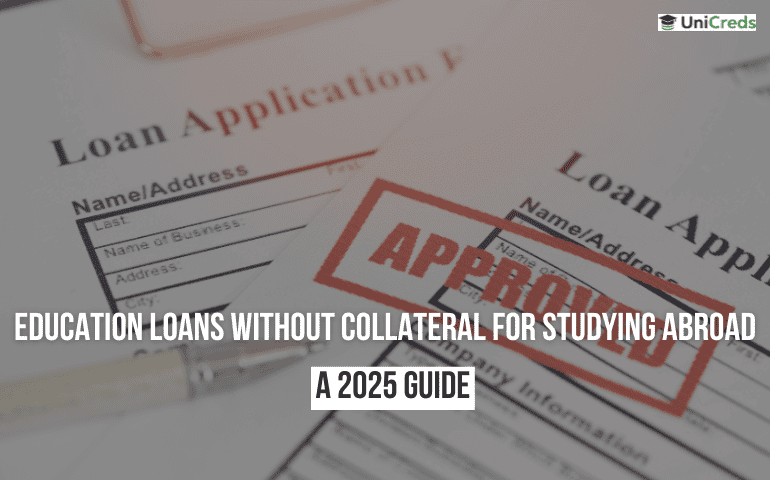Table of Contents
The dream to pursue your higher education abroad is becoming easier and more accessible by the day. The cost of studying abroad is no doubt expensive, but many banks have set up education loans to help students cover such costs. It’s important to consider how you will pay for your studies, regardless of whether you have already applied to your dream school or have been accepted. Before you start looking for a lender for an overseas study loan, you should get familiar with these 10 key education loan terms and conditions if you plan to apply for a loan.
10 Important Education Loan Terms And Conditions
Let’s jump right into learning about the 10 education loan terms and conditions that matter the most to you as someone who wants to study abroad:

Collateral
A collateral refers to a valuable asset that a borrower pledges to a lender as security for a loan. In case the borrower is unable to repay the loan as per the agreed-upon terms, the lender has the right to seize the collateral. A common instance where collateral is used is when a borrower takes out a mortgage, where the lender requires the borrower to pledge their home as collateral. Loan providers frequently ask for collateral in nations like India, and the value of the collateral may be greater than the loan amount.
Co-Signer
A co-signer is an individual who agrees to share the responsibility of repaying a loan with the primary borrower. In certain cases, qualifying for a private student loan necessitates the inclusion of a co-signer. If the co-signer has a good credit history, having one may enable the student borrower to secure the loan at a lower interest rate. In India, the phrase “co-borrower” is occasionally used, however in the US and UK, it has a different meaning. If you have a reliable co-signer, it’s occasionally feasible to get a loan in India without putting up any collateral.
Sanction letter Or Loan Confirmation Letter
In the education loan terms and conditions, a sanction letter from your lender, which details how much you’re borrowing, is required to demonstrate your ability to pay your university and the appropriate immigration officials. You might not be able to get your spot or your student visa without this paperwork. You should obtain a copy of this paper as soon as you can. Additionally, some lenders charge a fee for releasing your loan confirmation letter, however, this is not always the case.
Loan Duration or Repayment Period
What does the repayment period mean in the education loan terms and conditions? The total amount of time you have to pay back your loan, starting after your grace period and ending with your last payment, is known as the loan tenure or payback cycle. Although your interest rate will be lower with a longer loan term, you will pay more overall. There is no standard for overseas loan terms, however, you may anticipate finding possibilities between seven and twenty years.
EMI Or monthly payments
EMI, which stands for Equated Monthly Installment, is a predetermined fixed amount that a borrower of an education loan agrees to pay back to the lender on a monthly basis. This payment comprises two components: the principal amount borrowed and the applicable interest. Essentially, it is a convenient method of repaying the loan in equal, regular installments until the entire amount is paid off.
Moratorium Period
What does the moratorium term on student loans mean in the education loan terms and conditions? The time during which you are not required to make loan instalments is known as a moratorium period. Interest may still be charged on your loan during this period. You might be able to choose between loans if you are aware of the conditions of your moratorium period and how interest is calculated on your account. You’ll have time to plan out your post-graduation budget as well. Typically, simple compounding is used to calculate the interest charged on your loan throughout your moratorium period.
Penalty For Early Repayment
Early repayment fees or charges are what you must pay if you decide to pay back your loan early. The word prepayment penalties may also be present in the education loan terms and conditions. This enables lenders to recover a portion of the cash they anticipated making via interest. There aren’t many banks with early repayment penalties worldwide. However, it does happen, so you should be aware of these fees upfront.
Fees
A loan comes with a number of costs, including processing, admin, conversion and insurance fees. You need to be aware of what you’re being charged and when. Some lenders are completely clear about fees (especially in nations where APR is required). Lenders may collect fees in a variety of ways and at different times. Always take the necessary steps to thoroughly comprehend the costs associated with your loan.
Annual Percentage Rate (APR)
The annual percentage rate, commonly known as APR, plays a crucial role in determining the interest charged on loans on a yearly basis. It is an essential tool that empowers borrowers by providing insight into the potential costs associated with the loan borrowed, including the interest rate and additional charges. As loan providers structure their products differently, APR offers a comprehensive understanding of the total cost of the loan, making it easier for borrowers to compare offers from multiple providers and select the most suitable one for their individual needs.
Eligibility / Qualifications For A Student Loan Application
Typically, while applying for student loans, a person’s age must fall between 18 and 35. He or she must be pursuing a graduate, postgraduate, or post-graduate diploma. Additionally, the candidate must be guaranteed admission to a college or institution that is associated with the UGC, AICTE, etc.
Conclusion
We hoped this blog post will clarify some of the education loan terms and conditions related to student loans. If you meet all the necessary eligibility requirements and submit all the necessary paperwork, obtaining an education loan may be incredibly simple. Note that all the terms and conditions are dependent on the lender and banking partner. Your eligibility will also differ based on the lender and banking partner you choose.
FAQs
1. What is the terms and conditions for educational loan?
Opt for joint parent borrowers on education loans for extended repayment, a post-graduation moratorium, and up to 8 years of tax benefits on interest payments.
2. What is covered in education loan?
An education loan typically covers tuition fees, living expenses, exam-related costs, air travel tickets, and often includes health insurance.
3. What is the RBI rule for education loan?
Banks must offer moratorium periods, typically lasting the duration of the course plus an additional 6 months to 1 year, providing students with a buffer before commencing loan repayments.
4. Is loan processing fee refundable?
The processing fees for a home loan are non-refundable since they are a one-time payment that is an essential part of the loan application process.
5. What is the maximum term of education loan?
Regardless of the loan amount, the maximum repayment period will be 15 years, starting after the completion of the course and the moratorium period.
Popular Loans
Loans for studying in USA | Education loan for UK | Study loan for Canada | Education loan to study in Ireland | Education loan for studying in Australia | Loans for studying in New Zealand
Looking for student Education Loans?










0 Comments